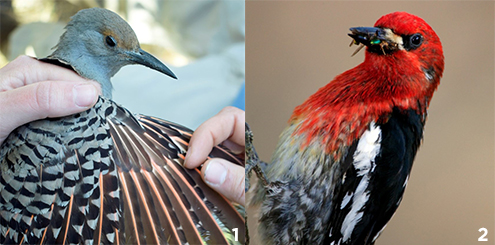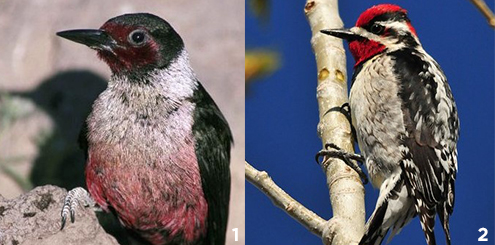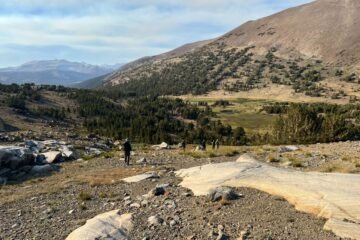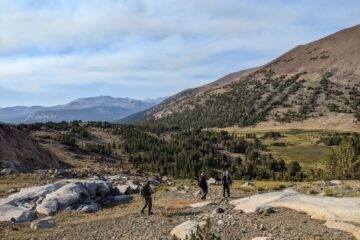You probably know that woodpeckers get their name because they … peck wood. A lot. In addition to foraging for food or carving out nest cavities, woodpeckers use their tree-tapping talents as a communication tool. Unlike songbirds, woodpeckers don’t have a wide range of vocal stylings, so use their percussive prowess to mark territory or show off for potential mates. Drumming tempos vary, but some species can beat their beaks against trees as many as 20 times per second.
Here are a few things you might not know about woodpeckers …
- They’re not always named woodpeckers. Some birds in the Picidae family are called sapsuckers or flickers (whose scientific genus, Colaptes, is related to the Greek word for “peck”). You might think that nutcrackers belong in the woodpeckers’ neck of the taxonomic tree, but they’re actually in the Corvidae family, with jays, crows, ravens and magpies.
- They’re omnivorous. In addition to eating insects, woodpeckers nosh on sap (especially the sapsuckers, which, as their name implies, dine on sap and sap-eating insects), nuts, and other plant materials.
- They’re natural tongue-twisters. Woodpeckers use their long tongues to spear or slurp up snacks … and then tuck their marvelous mouth muscles away by curling them backwards over their skulls, under the skin. Many woodpeckers have barbed or sticky tongues, ideal for ingesting insects.
- They vary widely in size. Pileated woodpeckers, the largest woodpecker species in Yosemite (and in North America), can be more than 18 inches long. Downy woodpeckers, another Yosemite-dwelling species, are only about a third the size of their pileated peers.
- They have built-in brain-protection – and nose-guards. Their anatomical structure, which includes small brains and strong neck muscles, is perfectly suited to cushion their skulls from forceful blows, and beak-adjacent bristles keep them from inhaling wood chips.
- They have unusual feet (compared to other birds, at least). In classic avian fashion, woodpeckers have four toes on each foot. While many other feathered flyers keep three toes forward (anisodactyl), woodpeckers distribute their quartet of digits in zygodactyl fashion, with two pointing forward and two pointing backward.
- They’re practically tripeds. In addition to using their atypical toe structure to balance on vertical trunks, woodpeckers wield their strong, stiff tails to brace themselves against bark and stay balanced as they peck away.
Worldwide, there are more than 200 Picidae species; of those, a diverse dozen can be found in Yosemite. Hoping to spot a woodpecker on your next trip to the park? Take a glance through the different species to see which ones you might encounter!
BEST BETS

1. Acorn woodpecker. These red-capped tree-nut-hoarders are abundant all year in the park. As you’d expect, they hang out around oak trees, at relatively low elevations (2,000′-5,000′). [Photo: Ann & Robb Simpson]
2. Hairy woodpecker. Despite the name, these black-and-white larvae-lovers are coated in feathers, not hair. You’ll find them in Yosemite year-round, in a variety of habitats, including conifer, hardwood and riparian areas, from 2,000 feet all the way up to 10,000 feet. [Photo: Pixnio]
3. Nuttall’s woodpecker. These small, chisel-billed birds are common in Yosemite, but unique to the West – their range is largely limited to California’s oak woodlands. Based on their name, you’d assume they eat all nuts, but they prefer to dine on ants, beetles and other tree-dwelling insects. (They’re named for Thomas Nuttall, a 19th-century botanist and bird-lover). [Photo: Dawn Beattie, CC-2.0 (creativecommons.org/licenses/by/2.0/legalcode), cropped]
4. White-headed woodpecker. Easily recognized by their striking white heads (surprise!), these four-season Yosemite residents dine on pines in mid-elevation forests (4,000′-7,000′). [Photo: Carolyn Botell]
SEASONAL SIGHTS

1. Northern flicker. Keep an eye out for these dashing brown birds (known as Pic flamboyant in French) in Yosemite in spring, summer and early autumn, when they frequent meadows, pine and oak forests, and riparian areas across a huge elevation range (2,000′-10,000′). (Pro tip: Look down! Flickers often feed on the ground.) [Photo: Yosemite Conservancy/Ryan Kelly]
2. Red-breasted sapsucker. Sporting scarlet heads and chests, these striking sapsuckers are most plentiful in the park in spring and summer months, when you might catch sight of them among riparian hardwoods or in conifer forests, between 2,000 feet and 8,000 feet. [Photo: Ann and Rob Simpson]
LESS COMMON LOOKS

1. Downy woodpecker. If you spy a bird that looks like an undersized hairy woodpecker with a dainty beak, you’ve probably spotted this petite species; downy woodpeckers are uncommon in Yosemite, but are sometimes seen in riparian and hardwood habitats at low elevations (2,000′-4,000′). [Photo: NPS/Ron Harden]
2. Williamson’s sapsucker. This species’ look varies wildly by sex: Males have black heads and bodies with sparse white stripes; females have brown heads and a salt-and-pepper pattern on their backs. Regardless of sex, they’re uncommon in the park, but you might catch a glimpse of one pecking at a pine in lower parts of the high country (6,000′-9,000′). [Photo: NPS]
3. Pileated woodpecker. With fiery red crests and 2-foot wingspans, pileated woodpeckers are easy to identify – if you can find them. This crow-sized Picidae are relatively rare in the park, but if you’re between 4,000 feet and 7,000 feet, you might spot one foraging for bugs in dead wood. [Photo: Carolyn Botell]
4. Black-backed woodpecker. This elegant bird, which sports tuxedo-esque outerwear and often opts for burned areas, is uncommon in the park, but you might catch a glimpse in upper montane coniferous forests (7,000′-9,000′). [Photo: USFWS]
RARE FINDS

1. Lewis’s woodpecker. Named for Meriwether Lewis (of Lewis and Clark fame), these birds stand out from their Picidae peers in a few ways, including their eating habits (they often go for airborne food) and feather color (pinkish red, green and gray). They cover a wide elevation range in Yosemite (2,000′-10,000′), but are rare in the park; still, keep an eye out if you’re hiking through hardwood and coniferous forests in spring, summer or early fall. [Photo: Pixnio]
2. Red-naped sapsucker. This scarlet-necked sap-sipper, known for drilling small wells in willows and other hardwood trees, is rare in Yosemite, but sometimes seen in spring, late summer or fall, between 2,000 feet and 7,000 feet. [Photo: USFWS/Tom Koerner]
Want to learn even more about Yosemite’s birdlife? Join one of our naturalist guides for a scheduled bird-watching wander (including our autumn woodpecker walk), or contact us to set up your own avian-focused Custom Adventure.
Above: A white-headed woodpecker perched on a tree in western Yosemite Valley. Photo: Yosemite Conservancy/Keith Walklet
Sources: Yosemite National Park, National Audubon Society, Cornell Lab of Ornithology



